Orphan Drugs Market Size
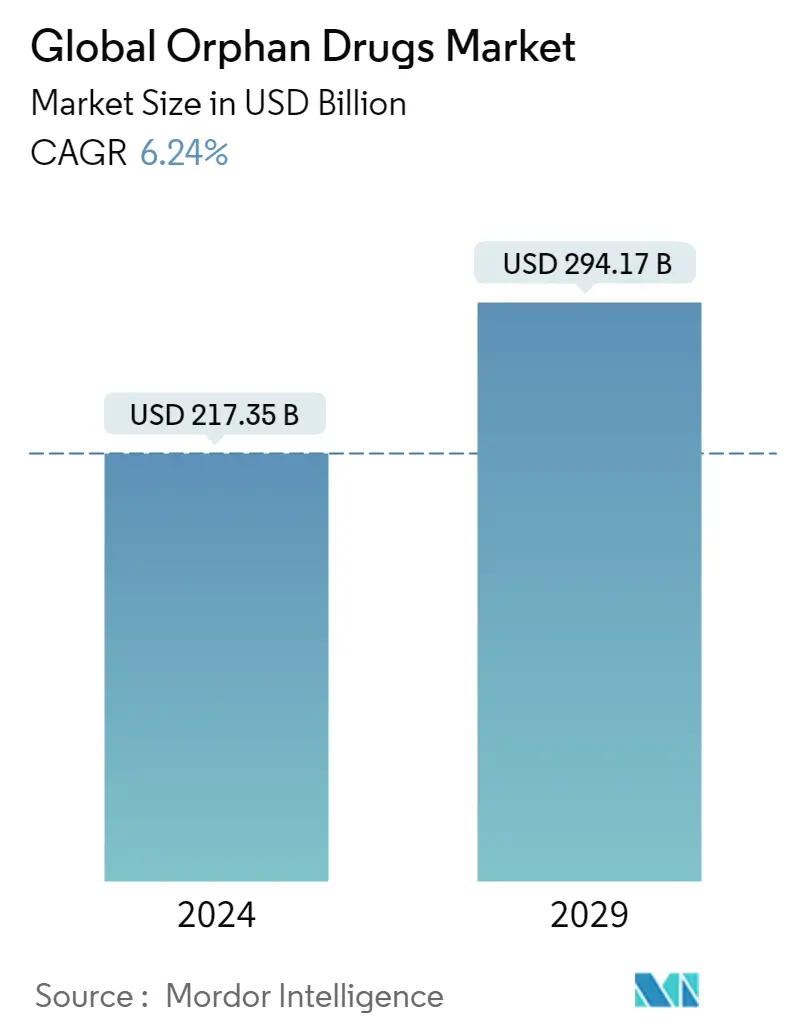
| Study Period | 2019 - 2029 |
| Market Size (2024) | USD 217.35 Billion |
| Market Size (2029) | USD 294.17 Billion |
| CAGR (2024 - 2029) | 6.24 % |
| Fastest Growing Market | Asia Pacific |
| Largest Market | North America |
Major Players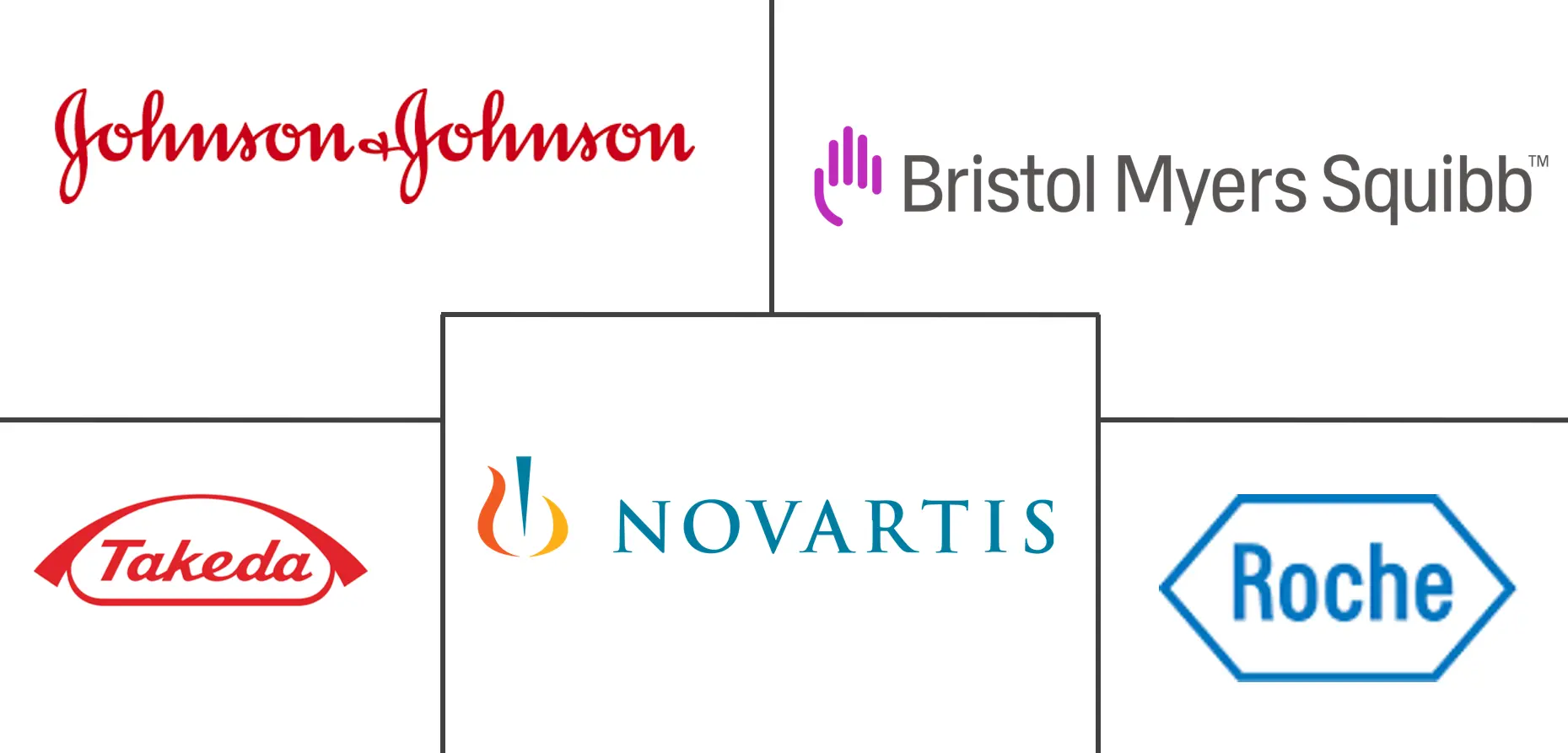
*Disclaimer: Major Players sorted in no particular order |
Orphan Drugs Market Analysis
The Global Orphan Drugs Market size is estimated at USD 217.35 billion in 2024, and is expected to reach USD 294.17 billion by 2029, growing at a CAGR of 6.24% during the forecast period (2024-2029).
The COVID-19 outbreak is an unprecedented public health concern that has had a significant impact on the orphan drug market globally as hospital and healthcare services were severely curtailed due to social exclusion and the supply chain was hampered. In September 2020, following criticism that treating covid-19 as a rare disease was "disingenuous," the United States Food and Drug Administration (FDA) has withdrawn orphan drug designation from a potential treatment for covid-19 from Gilead Science. Such instances may hamper the market growth during the pandemic. Thus, the pandemic is anticipated to have a significant impact on the studied market.
Some of the factors that are responsible for the growth of this market include market exclusivity for orphan drug developers, the rising prevalence of rare diseases, and favorable government policies.
Globally, the prevalence of rare diseases among the global population has been increasing in recent years. To tackle this issue, both developing and developed countries have formulated regulations that promote the development of drugs for rare diseases, as well as make sure that these drugs are easily availRare diseases: maintaining momentumable to patients. According to the Genetic and Rare Diseases (GARD) Information Center in May 2022, 1 in 10 Americans (or 30 million people) have a rare disease, and there are approximately 7,000 known rare diseases. Moreover, as per data updated in September 2021 by the "GlobalGenes", more than 400 million people worldwide are impacted by rare diseases. 80% of rare diseases have been identified with genetica origins. Moreover, as per the study titled "Rare diseases: maintaining momentum" published in March 2022, drug companies spent USD 22.9 billion in total in research on rare disorders in 2021, a 28% growth from 2020. Thus, growing prevalence and increasing research and development spending on rare diseases are creating opportunities for innovative orphan drugs. Thus, is expected to boost the market growth over the analysis period (2022-2027).
Additionally, favorable government policies for orphan drug approval and production support the market growth. Some of the countries with the well-recognized orphan drug act (ODA) include the United States, Japan, Australia, and Europe. Japan, with its health insurance for approximately 99% of its citizens, recently expanded its orphan drug criteria from less than 50,000 patients to less than 180,000 patients, to provide more opportunities for patients, payers, and providers, to achieve success against orphan diseases. In Europe, the European Medicines Agency (EMA) is the central organization related to facilitating the development and authorization of medicines for rare diseases. The approvals have been consistently high in the recent five years, across the European Union.
Furthermore, increasing research and development activities in the development of new therapies for rare diseases is also boosting the market growth. For instance, According to ClinicalTrails.gov in December 2021, a study titled "Oral Health-Related Quality of Life of Patients With Rare Diseases: a Qualitative Approach (RaroDentAXE3)" under the investigation from Assistance Publique - Hôpitaux de Paris is expected to be completed by December 2022. Thus, the rising number of studies on rare diseases is anticipated to boost the market growth over the forecast period.
Thus, all aforementioned factors are expected to boost the market growth over the forecast period. However, a limited patient pool for clinical trials and marketing restraint the market growth.
Orphan Drugs Market Trends
This section covers the major market trends shaping the Orphan Drugs Market according to our research experts:
Neurology Segment is Anticipated to Witness Growth Over the Forecast Period
Neurological disorders make up nearly half of these rare diseases. Due to the lack of screening tests, diagnostic genomic sequencing, and specialized clinical expertise, rare central nervous system (CNS) disorders are frequently challenging to identify and treat. There are about 5,000-8,000 rare diseases. Some neurological disorders include reflex sympathetic dystrophy syndrome, Battaglia-Neri syndrome, Creutzfeldt Jakob Disease, agnosia, Aicardi syndrome, and Aicardi-Goutieres syndrome. As per the report titled "Prevalence and incidence of rare diseases: Bibliographic data", published in January 2022, the prevalence of chronic inflammatory demyelinating polyneuropathy is 3.7 in Europe. However, the diagnosis of rare neurological diseases involves several barricades, such as a lack of awareness about rare neurological diseases within the population. Rare diseases are creating huge healthcare and economic burden worldwide.
The National Organization for Rare Disorders (NORD) data updated in June 2020 estimates that there are more than 7,000 rare diseases that are affecting more than 30 million Americans. In addition, about one-third of these are thought to include neurological components and symptoms. Additionally, as per the data published by the Center for Rare Neurological Disease Research in January 2021, rare neurological diseases affect approximately 200,000 individuals in the United States. Thus, the growing burden of rare neurological diseases drives the demand for orphan drugs.
According to the study titled "Using four decades of FDA orphan drug designations to describe trends in rare disease drug development: substantial growth seen in the development of drugs for rare oncologic, neurologic, and pediatric-onset diseases" published in the Orphanet of the Rare Diseases in July 2021, oncology (1910, 37%), neurology (674, 13%), and infectious diseases (436, 9%) were the top three therapeutic categories represented in the orphan drug designations.
Moreover, the growing approval of the Food and Drug Administration (FDA) for the orphan drug is anticipated to boost the segment growth. For Instance, in November 2021, PharmaTher Holdings Ltd. to receive Orphan Drug Designation ('ODD') for ketamine to treat Status Epilepticus, a rare neurological disorder requiring emergency treatment for a seizure.
Thus, all aforementioned factors are expected to boost the segment growth over the forecast period.
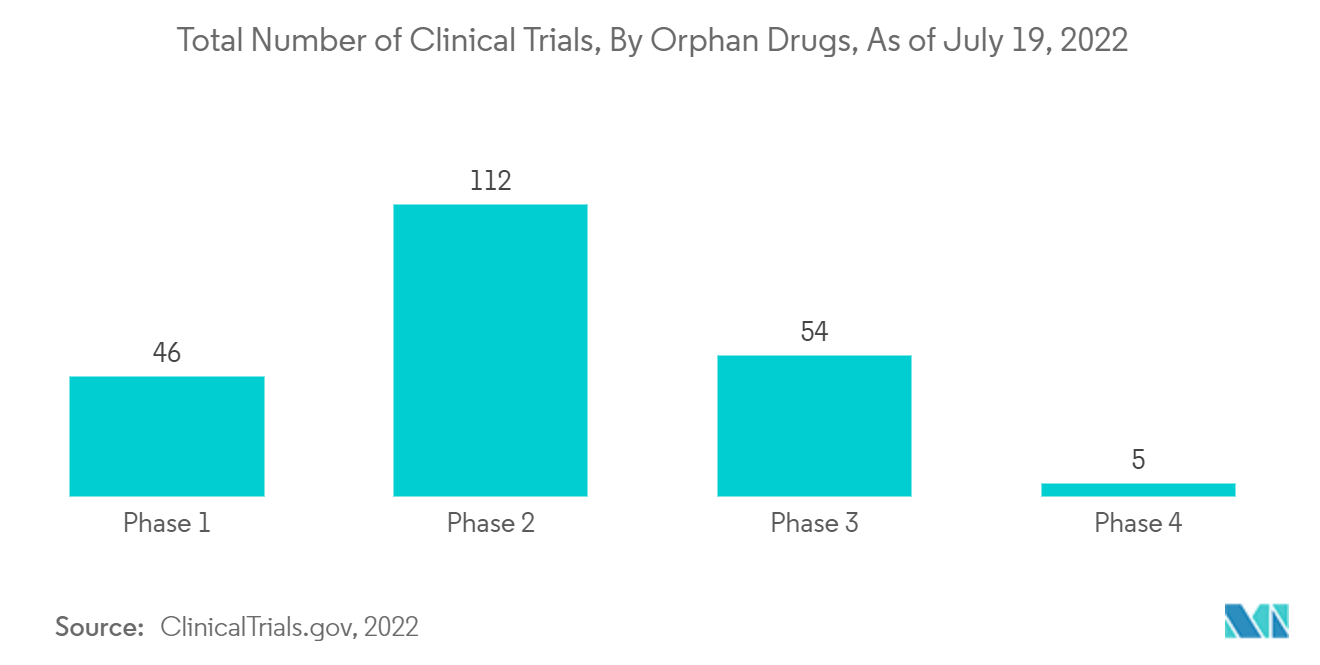
North America Dominates the Market and Expected to do the same in the Forecast Period
North America currently dominates the market for orphan drugs and is expected to continue its stronghold for a few more years. In the North American region, the United States holds the largest market share. One of the reasons for market growth is that in the United States, a drug-designated orphan drug status receives seven years of marketing exclusivity upon FDA approval for a specific indication, tax credits, and user fee waiver.
Furthermore, rare diseases are found in around 30 million Americans, according to data updated in May 2022 by the Genetic and Rare Diseases Information Center (GARD), and 3.1 million Canadians, according to the Canadian Organization for Rare Disorders (CORD) 2021 update. Due to the high prevalence in America, the government has provided support for patients with rare diseases through research grants and funds. With only 5% of rare diseases having FDA-approved treatment, the NIH has provided USD 31 million in grants to study rare diseases between 2019 and 2020. Similarly, in October 2020, the Food and Drug Administration (FDA) carried out the Orphan Drug Act and awarded over USD 16 million for six clinical trial research studies to industry and academia for the next four years.
Moreover, a growing number of drugs with the orphan drug designation is anticipated to boost the market growth. For instance, in June 2020, Agios Pharmaceuticals Inc., received the United States Food and Drug Administration (FDA) orphan drug designation for their pipeline candidate of Mitapivat for the treatment of Thalassemia. In May 2020, AstraZeneca Plc and Daiichi Sankyo Company received United States Food and Drug Administration (FDA) orphan drug designation for Enhertu (Trastuzumab deruxtecan) for the treatment of patients with gastric cancer, including gastroesophageal junction cancer.
Therefore, owing to the factors mentioned above the orphan drugs market is anticipated to grow in the North American region.
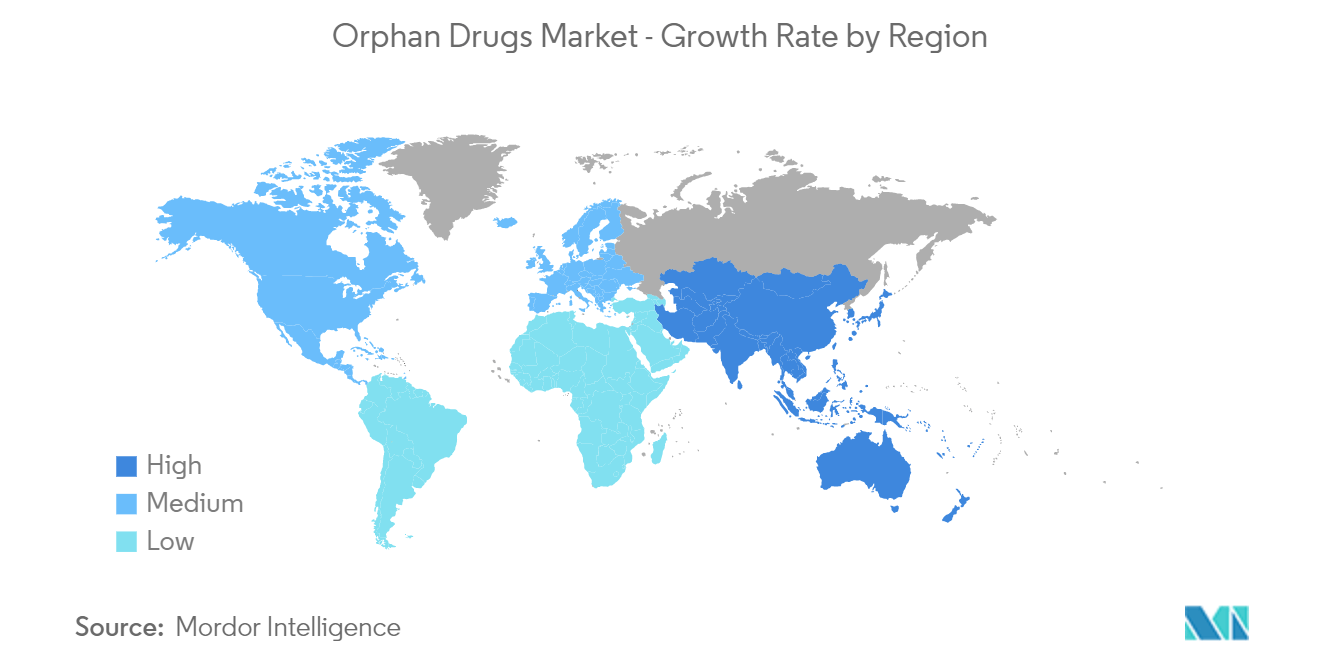
Orphan Drugs Industry Overview
The orphan drugs market is moderately competitive. In terms of market share, a few of the major players currently dominate the market. With the rising number of diseases and an increasing number of cases each year, a few smaller players are entering the market and holding a substantial share. Some of the market players include Celgene Corporation, Takeda Pharmaceutical Company Limited, Novartis AG, Johnson & Johnson, F. Hoffmann-La Roche Ltd and others.
Orphan Drugs Market Leaders
-
Takeda Pharmaceutical Company Limited
-
Novartis AG
-
Johnson & Johnson
-
F. Hoffmann-La Roche Ltd
-
Bristol-Myers Squibb Company (Celgene Corporation)
*Disclaimer: Major Players sorted in no particular order
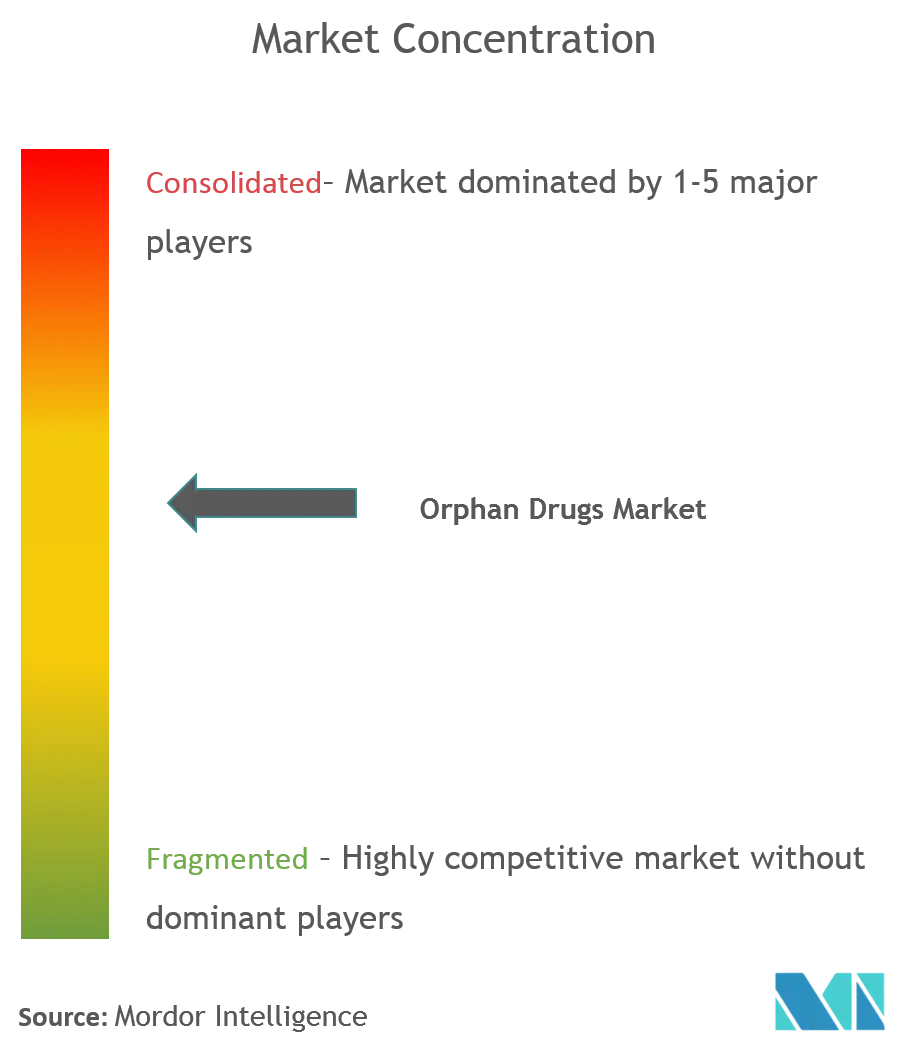
Orphan Drugs Market News
In June 2022, the Food and Drug Administration (FDA) granted orphan drug designation to evorpacept, a next-generation CD47 blocker, for the treatment of people with acute myeloid leukemia (AML), of ALX Oncology Holdings Inc.
In March 2022, the Food and Drug Administration designated a CRISPR-edited T cell receptor (TCR) T-cell therapy under investigation by Intellia Therapeutics as an orphan drug for the treatment of acute myeloid leukemia (AML)
Orphan Drugs Market Report - Table of Contents
1. INTRODUCTION
- 1.1 Study Assumptions and Market Definition
- 1.2 Scope of the Study
2. RESEARCH METHODOLOGY
3. EXECUTIVE SUMMARY
4. MARKET DYNAMICS
- 4.1 Market Overview
-
4.2 Market Drivers
- 4.2.1 Market Exclusivity for Orphan Drug Developers
- 4.2.2 Rising Prevalence of Rare Diseases
- 4.2.3 Favorable Government Policies
-
4.3 Market Restraints
- 4.3.1 High Per Patient Treatment Cost
- 4.3.2 Limited Patient Pool for Clinical Trials and Product Marketing
-
4.4 Porter's Five Force Analysis
- 4.4.1 Threat of New Entrants
- 4.4.2 Bargaining Power of Buyers/Consumers
- 4.4.3 Bargaining Power of Suppliers
- 4.4.4 Threat of Substitute Products
- 4.4.5 Intensity of Competitive Rivalry
5. MARKET SEGMENTATION (Market Size by Value - USD million)
-
5.1 By Drug Type
- 5.1.1 Biological
- 5.1.2 Non-biological
-
5.2 By Top Selling Drugs
- 5.2.1 Revlimid
- 5.2.2 Darzalex
- 5.2.3 Rituxan
- 5.2.4 Tafinlar
- 5.2.5 Ninlaro
- 5.2.6 Imbruvica
- 5.2.7 Myozyme
- 5.2.8 Soliris
- 5.2.9 Jakafi
- 5.2.10 Kyprolis
- 5.2.11 Other Top Selling Drugs
-
5.3 By Disease Type
- 5.3.1 Oncology
- 5.3.2 Hematology
- 5.3.3 Neurology
- 5.3.4 Cardiovascular
- 5.3.5 Other Disease Types
-
5.4 Geography
- 5.4.1 North America
- 5.4.1.1 United States
- 5.4.1.2 Canada
- 5.4.1.3 Mexico
- 5.4.2 Europe
- 5.4.2.1 Germany
- 5.4.2.2 United Kingdom
- 5.4.2.3 France
- 5.4.2.4 Italy
- 5.4.2.5 Spain
- 5.4.2.6 Rest of Europe
- 5.4.3 Asia-Pacific
- 5.4.3.1 China
- 5.4.3.2 Japan
- 5.4.3.3 India
- 5.4.3.4 Australia
- 5.4.3.5 South Korea
- 5.4.3.6 Rest of Asia-Pacific
- 5.4.4 Middle East and Africa
- 5.4.4.1 GCC
- 5.4.4.2 South Africa
- 5.4.4.3 Rest of Middle East and Africa
- 5.4.5 South America
- 5.4.5.1 Brazil
- 5.4.5.2 Argentina
- 5.4.5.3 Rest of South America
6. COMPETITIVE LANDSCAPE
-
6.1 Company Profiles
- 6.1.1 Alexion Pharmaceuticals
- 6.1.2 Bristol-Myers Squibb Company (Celgene Corporation)
- 6.1.3 Novartis AG
- 6.1.4 Pfizer Inc.
- 6.1.5 F. Hoffmann-La Roche Ltd
- 6.1.6 Takeda Pharmaceutical Company Limited
- 6.1.7 Amgen Inc.
- 6.1.8 Sanofi S.A
- 6.1.9 Johnson & Johnson
- 6.1.10 AstraZeneca Plc
- 6.1.11 AbbVie Inc.
- 6.1.12 GlaxoSmithKline Plc
- 6.1.13 Daiichi Sankyo Company Limited
- 6.1.14 Bayer AG
- *List Not Exhaustive
7. MARKET OPPORTUNITIES AND FUTURE TRENDS
** Subject To AvailablityOrphan Drugs Industry Segmentation
As per the scope of the report, orphan drugs can be defined as a molecule intended to treat a rare disease. The rare disease, as the name suggests, has a low prevalence rate and has been defined differently across geographical locations. The Orphan Drugs Market is Segmented by Drug Type (Biological, Non-biological), Top Selling Drugs (Revlimid, Darzalex, Rituxan, Tafinlar, Ninlaro, Imbruvica, Myozyme, Soliris, Jakafi, Kyprolis, Other Top Selling Drugs), Disease Type (Oncology, Hematology, Neurology, Cardiovascular, Other Disease Types) and Geography (North America, Europe, Asia-Pacific, Middle East and Africa, and South America).The market report also covers the estimated market sizes and trends for 17 different countries across major regions globally. The report offers the value (in USD million) for the above segments.
| By Drug Type | Biological | |
| Non-biological | ||
| By Top Selling Drugs | Revlimid | |
| Darzalex | ||
| Rituxan | ||
| Tafinlar | ||
| Ninlaro | ||
| Imbruvica | ||
| Myozyme | ||
| Soliris | ||
| Jakafi | ||
| Kyprolis | ||
| Other Top Selling Drugs | ||
| By Disease Type | Oncology | |
| Hematology | ||
| Neurology | ||
| Cardiovascular | ||
| Other Disease Types | ||
| Geography | North America | United States |
| Canada | ||
| Mexico | ||
| Geography | Europe | Germany |
| United Kingdom | ||
| France | ||
| Italy | ||
| Spain | ||
| Rest of Europe | ||
| Geography | Asia-Pacific | China |
| Japan | ||
| India | ||
| Australia | ||
| South Korea | ||
| Rest of Asia-Pacific | ||
| Geography | Middle East and Africa | GCC |
| South Africa | ||
| Rest of Middle East and Africa | ||
| Geography | South America | Brazil |
| Argentina | ||
| Rest of South America |
Orphan Drugs Market Research FAQs
How big is the Global Orphan Drugs Market?
The Global Orphan Drugs Market size is expected to reach USD 217.35 billion in 2024 and grow at a CAGR of 6.24% to reach USD 294.17 billion by 2029.
What is the current Global Orphan Drugs Market size?
In 2024, the Global Orphan Drugs Market size is expected to reach USD 217.35 billion.
Who are the key players in Global Orphan Drugs Market?
Takeda Pharmaceutical Company Limited, Novartis AG, Johnson & Johnson, F. Hoffmann-La Roche Ltd and Bristol-Myers Squibb Company (Celgene Corporation) are the major companies operating in the Global Orphan Drugs Market.
Which is the fastest growing region in Global Orphan Drugs Market?
Asia Pacific is estimated to grow at the highest CAGR over the forecast period (2024-2029).
Which region has the biggest share in Global Orphan Drugs Market?
In 2024, the North America accounts for the largest market share in Global Orphan Drugs Market.
What years does this Global Orphan Drugs Market cover, and what was the market size in 2023?
In 2023, the Global Orphan Drugs Market size was estimated at USD 204.58 billion. The report covers the Global Orphan Drugs Market historical market size for years: 2019, 2020, 2021, 2022 and 2023. The report also forecasts the Global Orphan Drugs Market size for years: 2024, 2025, 2026, 2027, 2028 and 2029.
Orphan Drug Industry Report
Statistics for the 2024 Orphan Drug market share, size and revenue growth rate, created by Mordor Intelligence™ Industry Reports. Orphan Drug analysis includes a market forecast outlook to 2029 and historical overview. Get a sample of this industry analysis as a free report PDF download.



